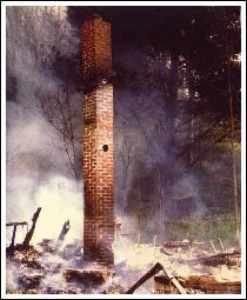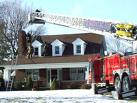Sweeping your chimney is part of having a wood stove or open wood burning fireplace.
Sweeping your chimney with chimney sweeping brushes and rods or having your chimney swept by a chimney sweep is part of the correct operation of your stove or fireplace and is one of the most important tasks that there are associated with having a woodstove. Tar, soot and deposit build up in a chimney can restrict the area in the chimney, reducing draw, making the chimney draft poorly and in the end can make the fireplace smoke. If you have a soot fall in the chimney this can block the flue leading from fireplace opening and make it smoke a lot. The build up of deposits in your chimney can also lead to a chimney fire which you really don't want to happen.
When creosote deposits or wood tar deposits build up to a sufficient level there is the risk of chimney fire. The heat from the fire warms the deposits releasing the combustible volatiles until they ignite. The fire then migrates up the chimney as the burning deposits heat the chimney above.
How to tell if you have a chimney fire - You will often hear a roaring noise in the chimney, especially with an open fire. Outside masses of smoke will be pouring out of the chimney.
When you start to see flames coming out of the chimney you know that the chimney fire is near it's end.
What to do if you have a chimney fire
1. Call the fire department - 911
2. If you have a stove then shut all air vents and flue dampers to reduce the chimney fire's oxygen supply.
3. If you have an open fire in the fireplace, try to extingquish the logs that are burning with an approved fire extingquisher.
4. Move flammable materials, furniture, ornaments away from the fireplace.
5. If you have an open fire (as long as there is no risk to you) block the fireplace opening with something noncombustible.
6. Feel the walls adjacent to the chimney - if they are getting hot, move furniture away from them.
7. Do not pour water on the fire if you have a wood stove.
8. Do not pour salt on the fire - this can create chlorine gas which is damaging to the chimney and toxic if it gets into the home.
9. Ensure that the fire department can access the attic area.
10. In severe cases, where there is a risk of the fire spreading to the roof, use a hose to wet down the roof near the chimney but not the chimney itself. Spraying cold water directly on the hot chimney could cause the brick to crack or explode.
.
About chimney fires
Wood tar chimney fires can create temperatures up to 1200 degrees centigrade inside the chimney.
Clay liners - a chimney fire will often cause clay liners to crack and therefore the chimney will probably need to be relined (you may be able to claim for this under your household fire insurance). Contact us for advice.
As the chimney heats up during the chimney fire it expands - this causes plaster work to crack and even blow off and can cause structural damage to the chimney.
Temperatures can reach so hot, that the " thermal expansion " of the chimney liners can cause the mortar joints to fall out, thus causing the fire to spread into the walls of the home.
Worst case scenario chimney fires.
Chimney deposits are intumescent and expand when heated. In the worst case scenario they can expand to the extent that they block the chimney. The chimney fire will then seek oxygen from the nearest available source - usually the stove or fireplace - which means that the fire can come out of the bottom of the chimney.
In extreme cases where the integrity of the top of the chimney is already compromised the top courses of brick can blow off due to the pressures inside the blocked chimney.
Heat from the chimney fire can transfer into joists and weaken them through smoldering and cause them to catch fire. Sparks and debris flying out of the chimney can also set fire to the roof.
How often you should sweep really depends on the construction and type of your chimney, what fuel you are using, how well your wood fuel is seasoned, and how often you use your stove or fireplace. At least sweep your chimney once at the end of the burning season. You may need to sweep more than this depending on how much creosote deposits have accumulated.
Oil furnaces and gas furnaces and boilers:
Many people assume that when their heating technician comes each year to service the furnace or boiler, that the chimney is okay. Most heating companies never check the chimneys. It is very important to have the furnace or boiler flues checked for excessive creosote build up or blockage. As little as one quarter of an inch of creosote build up in you flue can decrease the operating efficiency of your appliance by 15 percent!!!
Damage caused by chimney fires
Call us today for a free quote 804-304-8911
How often should you sweep your chimney?
SITE MAP
SITE MAP
London Sweeps, Chimney Sweeps LLC









